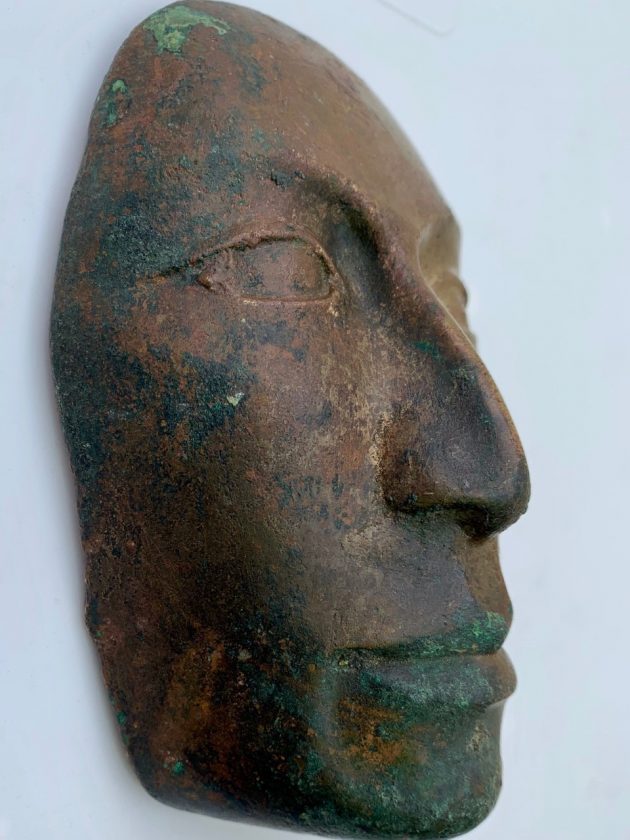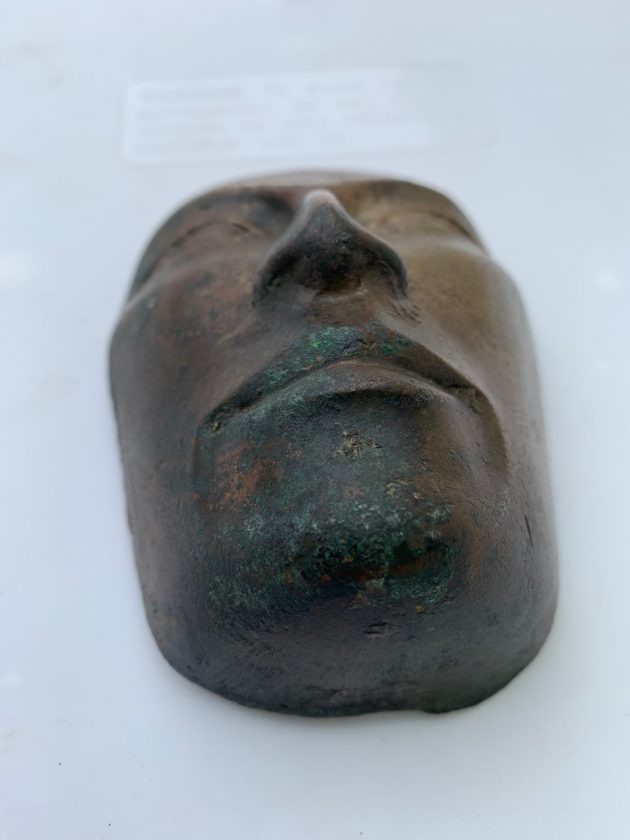Mysterious antique mask found in Marshall County

CONTRIBUTED PHOTOS — The mask allegedly discovered near the Iowa River in Marshall County, and now owned by longtime researcher and collector Frank Waite who is looking for answers on the object’s origin.
An old mask allegedly unearthed in Marshall County has piqued the interest of state archaeologists and the owner is looking for answers.
Approximately five years ago, longtime antique collector and researcher Frank Waite discovered a mysterious mask at Iowa River Antiques in Marshalltown.
“At first I wasn’t sure what it was,” Waite said. “I picked it up and it was really dense and heavy, like lead or something. Just really dense metal for the size of it.”
Iowa River Antiques owner Mike Awes said he does not remember who sold him the mask, but recalls the story of its recovery. A local farmer supposedly uncovered the object while plowing a field near the Iowa River. The mask remained in the farmer’s home for years until the farmer passed and the mask was sold along with his estate.
Now having the free time to research the object, Waite took the mask for a X-ray diffraction test to discover what material the mask was made from. The test revealed the mask was 99.8 percent pure copper. The tester believed the copper to be native copper, a form of historic and more valuable copper uncombined with other materials, due to the mask’s high density and appearance.

Waite is now looking for any information on who may have sold the mask to Iowa River Antiques, as discovering exactly where the artifact was discovered will aid in learning the mask’s age and origin.
State Archaeologist from University of Iowa John Doershuk said the mask is an unusual find given the context it was found in.
“If a farm did in fact find it while plowing the fields, there’s the question of how on earth it got there,” Doershuk said. “One of the possibilities is that it’s archaeological, maybe dating to some time deep in the past because past people in North America did use copper as a raw material. But then you have to start looking at it more closely. Is it copper that would have been available to North Americans or is it copper from some other part of the world? Then you start having to look at how it’s manufactured.”
He said context is everything in archaeological investigations.
“There could be substantiation that the mask was actually found in Marshall County,” Doershuk said. “That puts it in a different light if in fact the mask was bought and sold and traded and moved all over the world. These pieces sometimes get traded far and wide.”

The remaining unknown 0.2 percent of the mask’s contents may provide some answers. While the mask’s material is of high value, the density of the copper doesn’t necessarily demonstrate its native he said. He and colleagues suggest additional testing to clarify where the copper was mined to be sure of the mask’s origin.
Waite originally suspected the mask to be Hopewellian, a part of a pre-columbian Native American Civilization. Doershuk and colleagues are leaning toward the mask being North American in origin but dating to post-European expansion into the region.
The technique in which the mask was made can also provide answers.
Doershuk said Native Americans were adept at the cold-hammering technique, where the metal is heated and hammered into shape. This technique is opposed to casting, where the metal is melted and poured into a mold.
Waite said it’s not unusual for farmers to find ancient objects in their fields.
“People find stuff all the time,” Waite said. “Back in the day they didn’t know what it was. They either kept it or threw it away. A lot of them just plowed over stuff and didn’t know they were going over an archaeological find.”
——
Contact Trevor Babcock at 641-753-6611 or tbabcock@timesrepublican.com.
- CONTRIBUTED PHOTOS — The mask allegedly discovered near the Iowa River in Marshall County, and now owned by longtime researcher and collector Frank Waite who is looking for answers on the object’s origin.









